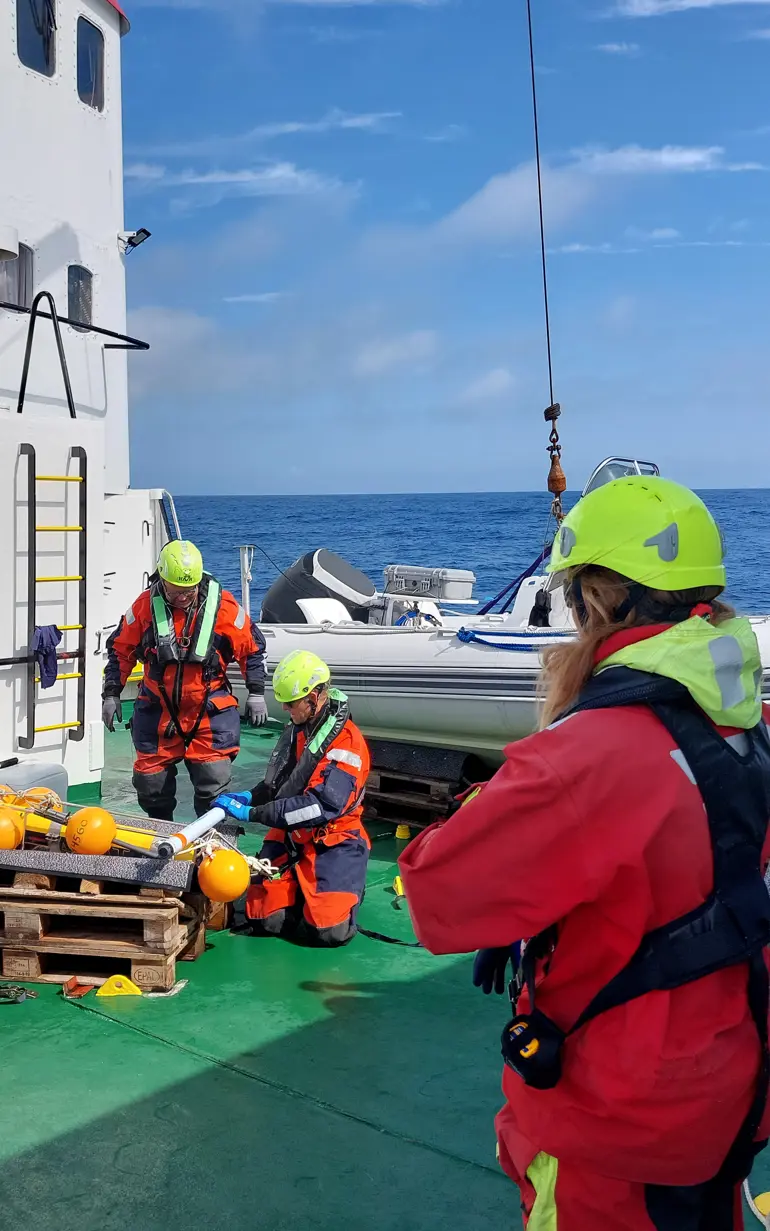
Researchers collect important data on artificial reefs beneath offshore platforms
Life at sea is under pressure in many places but may be less so around our Danish North Sea platforms. Researchers from DHI, DTU-Aqua and Aarhus University-EcoScience are now gathering critical environmental and biodiversity data to better understand the role of the platforms in attracting marine life. The findings will contribute to the future protection of biodiversity around offshore platforms.
A dedicated team of researchers and specialists from TotalEnergies and DHI has just returned from a three-week long biodiversity research expedition in the Danish North Sea. The research team collected seabed samples from several of the Danish Underground Consortium's (DUC) offshore platforms.
They also gathered 12 offshore underwater sensors placed last summer at the Skjold field as part of the project by TotalEnergies with DUC, DTU Offshore, DTU Aqua and Aarhus University-EcoScience, and set out four new sensors at the Tyra, Harald, Dan and Skjold fields.
'The underwater sensors, so-called hydrophones, record the behaviour of tagged cod and echolocating marine mammals such as harbour porpoise around our offshore platforms. This helps us better understand the role our platforms play as feeding and spawning grounds for marine life. The preliminary results from our initial study show that the closer you move to the platforms, the more fish you will find, and the larger they are', says Senior Scientist Jon C. Svendsen, DTU Aqua.
The new sensors have been deployed across different oil and gas platforms to also collect insights on the distribution of cod and harbour porpoises between the various locations.
'In the second phase of the study, we broadened the scope from one offshore field to four fields. This will help us to provide insights into the movement of the tagged cod and whether harbour porpoises use other similar platforms. We are positive that the quality of the data collected will fill important scientific knowledge gaps to be used both in the oil and gas, as well as the wind industry', says Professor Jonas Teilmann at Department of EcoScience at Aarhus University in Roskilde.
Offshore platforms as reef habitats
Many offshore platforms have been in operation for over 30 years. Over their long lifespans, they have not only contributed to energy security, but they have provided spawning and feeding grounds for marine life.
'When planning for decommissioning, platform owners, authorities and policymakers must consider the marine environmental impact of removing the offshore structures. Growing evidence suggests that platform legs provide reef habitats for fish and marine mammals, so it is important that we collect a solid data foundation to make informed decisions', says Charlotte N. Larsen, Program Manager at DTU Offshore - Danish Offshore Technology Center.
During the coming months, the analysis of all data collected will continue. The sensors just deployed will be picked up by the end of this year and thereby mark the end of this project's field campaign.
'The North Sea is the home of our Danish operations, so it is crucial we understand the marine life around our platforms. We are pleased and proud to collaborate with skilled researchers and experts to gain valuable knowledge about the environment and biodiversity trends around platforms. The data guides our decisions relating to activities at sea, and our hope is that the wider society, including industry, authorities and policymakers can also benefit from it,' says Katrina Povidisa-Delefosse, Senior Environment Advisor at TotalEnergies Denmark and PhD in Marine Biology.
TotalEnergies, along with DUC partners BlueNord and Nordsøfonden, and DHI will launch an open data portal – the North Sea Environment Portal – which will provide access to more than 30 years of data on environmental and biodiversity trends.
'The many surveys undertaken by DHI and TotalEnergies with DUC over the years enabled a deep understanding of the development of seabed chemistry and the invertebrate fauna at and around the platforms. The long-term data allows us to study trends in seabed chemistry and the composition and number of invertebrate species including mussels, snails and bristle worms. Notably, the data shows an increase in the number of invertebrate species over time', says Senior Project Manager and Biologist Jesper Goodley Dannisøe from DHI.
The data collected will be added to the North Sea Environment Portal, which will launch in the fourth quarter of 2024.
Further material
Download relevant visual materials here
Watch DTU’s videos that visually explain the biodiversity study here
Contact
For press enquiries, please contact Annette Mystek, acmy@dhigroup.com
How can we help?
With our global network of offices, we make sure you get the right answers to your local needs. Tell us about your water challenges and we will get back to you.